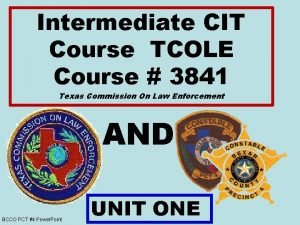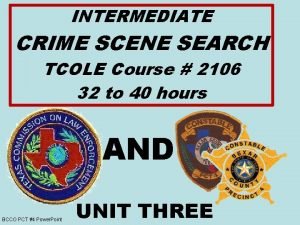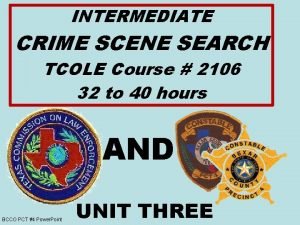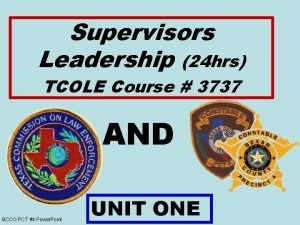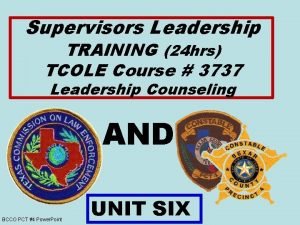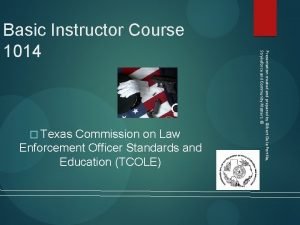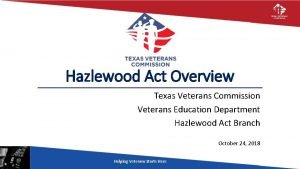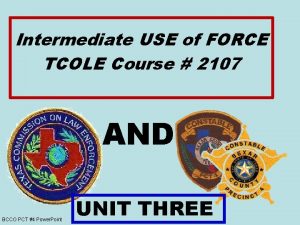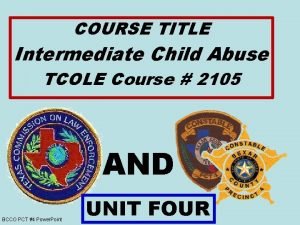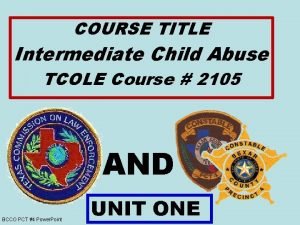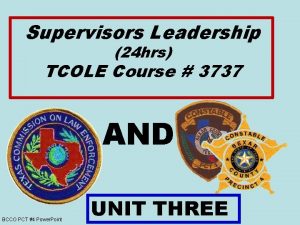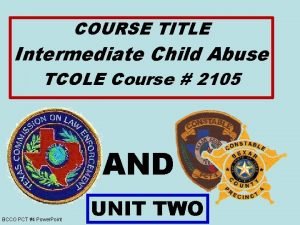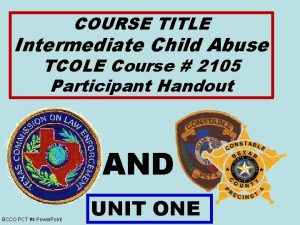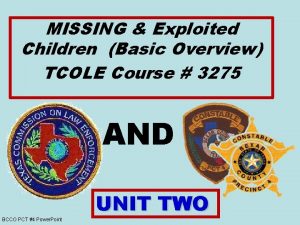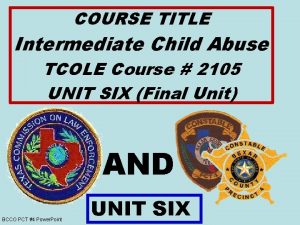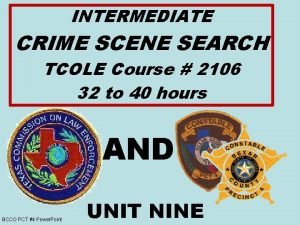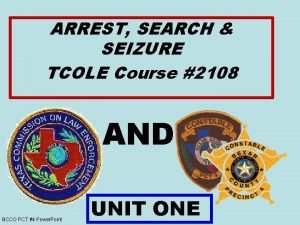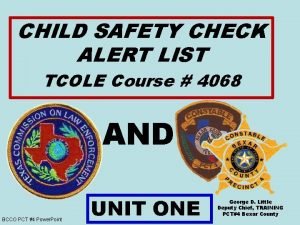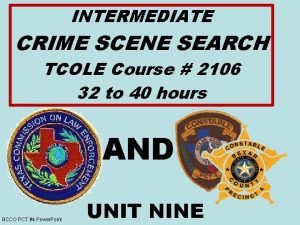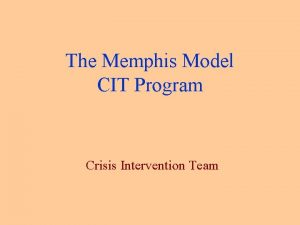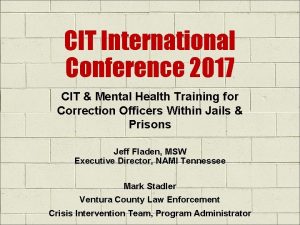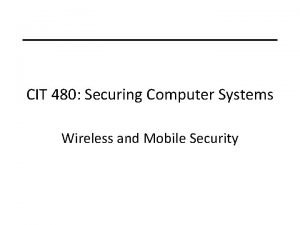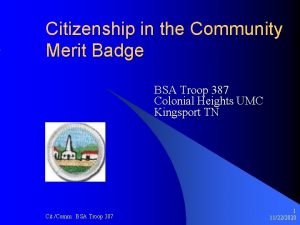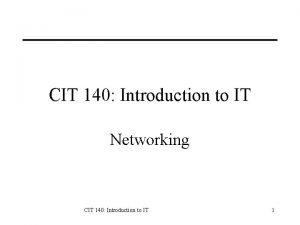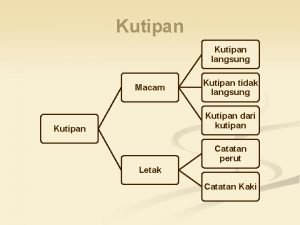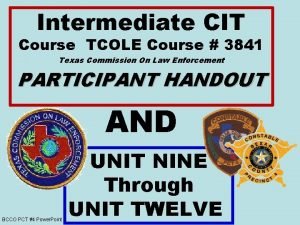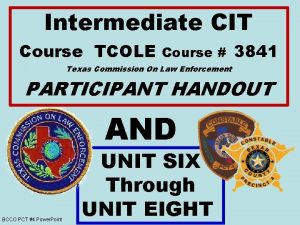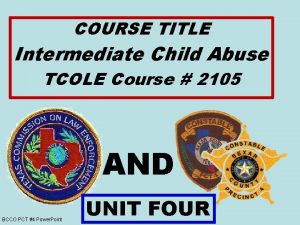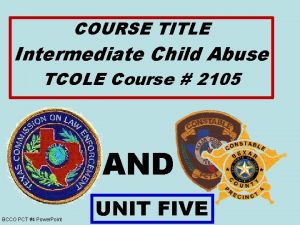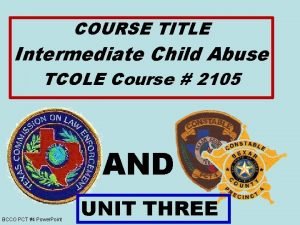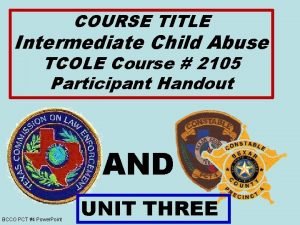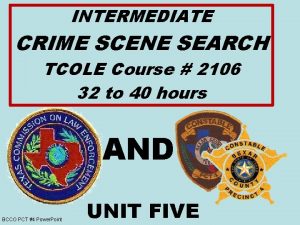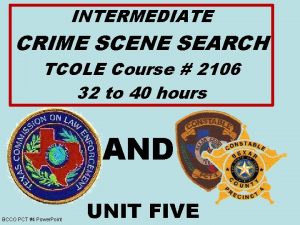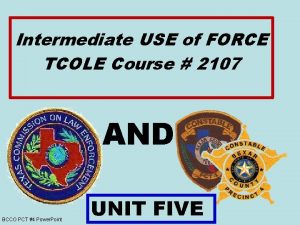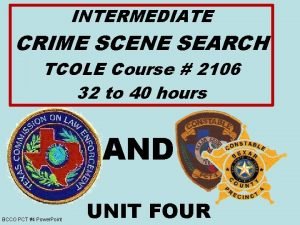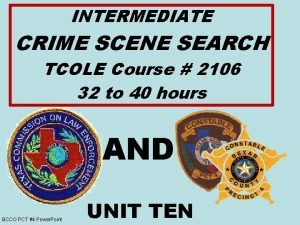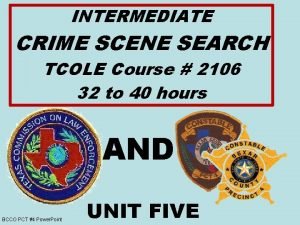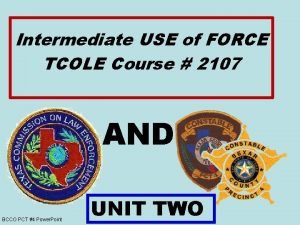Intermediate CIT Course TCOLE Course 3841 Texas Commission


































































- Slides: 66

Intermediate CIT Course TCOLE Course # 3841 Texas Commission On Law Enforcement AND BCCO PCT #4 Power. Point UNIT ONE

ADMINISTRATIVE • Please complete the BCCO PCT #4 Registration form and turn it in now. • Make sure you sign TCOLE Report of Training (PID#, Full Name and DOB). • All cell phones off please – pay attention to course materials and show common respect & courtesy.

Your Instructor – Course Facilitator and Mentor Trainer Deputy Chief George D. Little A. S. & B. S. Criminal Justice & Sociology B. S. CJ Wayland Baptist University, San Antonio M. S. Criminology & Counter-Terrorism University of the State of New York(P) 2012 T. C. O. L. E. Professional Achievement Award Certified Crime Prevention Specialist (C. C. P. S. ) FAMS TCOLE Basic Instructor Certificate 1984 CERTIFIED TCOLE Advanced Instructor 2012 INSTRUCTOR TCOLE Master Peace Officer 1991 MP Special Operations Operator Counter-Terrorism 1988 Military Police Investigations (MPI) & Criminal Investigation Division (CID) Special Agent Graduate Drug Enforcement Administration Academy 1977 43 - years Law Enforcement Experience 11/30/2020 39 -Years Teaching & Instructor Experience 3

Learning Objectives See your Participant Handout for complete list of all goals established in this course with each individual learning objective listed under each unit (goal)

Opening Statement With increasing frequency, law enforcement is being called upon to respond to individuals in serious mental health crises

COURSE/LESSON OVERVIEW – Cont’d It is necessary for the law enforcement personnel to understand mental illness, and the tactics and techniques that have been proven to work most effectively when responding to individuals in these situations

COURSE/LESSON OVERVIEW – Cont’d These tactics and techniques are different than those routinely taught to officers to control conflict which, due to the underlying elements behind the behavior, is usually not of a criminal or malicious intent

COURSE/LESSON OVERVIEW – Cont’d This information can help keep the officer safe, safe keep the mental health consumer safe, safe and greatly reduce liability on the part of the officer and the agency

Crisis Intervention Training Intermediate CIT Course Number 3841 Texas Commission On Law Enforcement 9

Unit Goal 1. 1. To develop a basic understanding and respect for the fundamental rights of and proficiency in interacting with people with mental illness. 10

Top Cop Video (View ‘Top Cop’ video from “Train the Trainer” course materials 11

1. 1. 1. • Discuss the impetus for crisis intervention training and why it is so important to the law enforcement community. 12

Origin of the Training • Memphis (TN) officers shot and killed a 26 -year-old male who was cutting himself with a knife and threatening suicide • The public outcry in the aftermath of the shooting caused the mayor to establish a task force 13

Origin of the Training • Crisis Intervention Training (CIT) was created -Practitioner Perspective -Bureau of Justice Assistance July 2012 14

Similar Situations Today • “The San Francisco Police Commission approved a $500, 000 legal settlement with the family of a mentally disturbed man who was shot and killed in 2001 by police as he waved a knife at them in a theater. ” — Jaxon Van Derbeken — San Francisco Chronicle June 5, 2003 15

New YORK PD – Detective who attempted to disarm a mentally challenged individual

Similar Situations Today Continued • “The fatal shooting of a mentally ill man on Thursday marked the third time in six months that Philadelphia police have used deadly force to subdue an unruly person in need of psychiatric help. ” “Police Shootings of Mentally Ill Show Training Needed” 17 www. healthyplace. com February 21, 2004

Similar Situations Today Continued • “The Miami-Dade police department in southern Florida began sending every officer to a two-day class entitled ‘Managing Encounters with the Mentally Ill’ … after officers killed a 19 -year-old man suffering from bipolar disorder. ” disorder “Police Shootings of Mentally Ill Show Training Needed” Ø www. Healthy. Place. com 18 Ø February 21, 2004

Similar Situations Today Continued • “A 16 -year Austin police officer used deadly force Tuesday morning, killing an east Austin woman as she apparently tried to attack a housing manager with a butcher knife. … within moments of the shooting, east Austin residents were questioning whether the woman’s death could —www. news 8 austin. com have been avoided. ” — Incident occurred in 2002 19

Similar Situations Today Continued • The treatment advocacy center in Washington, D. C. reported that people with psychiatric disabilities are four times as likely to die in encounters with police as members of the general population. 20 Ø Treatment Advocacy Center Washington DC

Headlines… “Crisis Skills Advised for Local Ø Los Angeles Times Police” Police Ø Ventura County Edition Ø February 27, 2002 “Report: Grand jury finds that most fatal shootings by law enforcement officers in last decade involved a mentally ill person” 21

Headlines…”Cont’d” “Training urged after police shooting” “The weekend death of a mentally disabled man shot by a Miami. Dade police officer… department to offer its officers more intensive training. ” ØThe Miami Herald ØHerald. com ØPosted Thursday, October 28, 2004 22

1. 1. 2. Recognize the community mindset as it relates to the mentally ill’s relationship with law enforcement personnel 23

Community Mindset • Individuals with mental illness are traditionally not hardened criminals and should not be treated as such. • Law enforcement should respond differently to individuals in mental health crises. • Force, Force in these situations, is highly scrutinized. 24

The Problem • Re-occurring situations in which law enforcement uses deadly force during encounters with individuals in serious mental health crisis 25

Aspects of the Problem • “There is no question that law enforcement officers are increasingly the ones responding to people with mental illnesses who are in crisis. ” Ø Treatment Advocacy Center Briefing Paper Ø www. psychlaws. org 26 Ø 10/2004

Results • Lawsuits/Liability • Lack of trust/confidence in law enforcement by mental health consumers and their families • Frustration of law enforcement due to uncertainty of how to handle these calls 27

Analysis of the Problem • Lack of education - understanding of mental illness by law enforcement • The same physical, authoritative, command tactics employed to take a criminal suspect into custody are used in responses to individuals in mental health crises 28

Analysis…Cont’d • Individuals with mental illness are traditionally not hardened criminals. • The public views these individuals as ill, not criminal. The public expects law enforcement personnel to help not hurt 29

Analysis…Cont’d • An analysis of 1439 CIT calls revealed that only 1% of the individuals in a mental health crisis were arrested. • Of the remaining 99% of the incidents, no crime or a petty class C crime was committed without arrest. 30 Houston Police Department 2004

Analysis…Cont’d • Response to individuals in a mental health crisis constitutes a more refined usage of the officer’s expertise in communication. 31

Analysis…Cont’d • “If police perform their role effectively, our society benefits immeasurably; • if the police perform their role poorly, the damage to public confidence and democratic principles can be irreparable. ” (Louis/Resendez, 1997)

The Responses: 3 Models 1. Police-based specialized police response (CIT) 2. Police-based specialized mental health response 3. Mental-health-based specialized mental health response 33

1. 1. 3 • Illustrate the paradox of Crisis Intervention Training for the law enforcement officer. 34

The Paradox • By taking a less physical, less authoritative, less controlling, less confrontational approach the officer usually has more authority and control over the person in a mental health crisis. 35

Police Magazine (March 2000) • “The essential difference between suspect encounter training, that officers traditionally receive, and how to approach the mentally ill is the need to be non confrontational 36

Police Magazine (March 2000) – Cont’d • Such a requirement to, in effect, switch gears is diametrically opposed to the way officers are routinely expected to control conflict. ”

Police Magazine (March 2000) – Cont’d • “The same command techniques that are employed to take a criminal suspect into custody can only serve to escalate a contact with the mentally ill into violence. ” 38

1. 1. 4. • Explain Crisis Intervention’s role in Officer 39

CIT Model • “CIT has been shown to positively impact officer perceptions, decrease the need for higher levels of police intervention, intervention decrease officer injuries, and re-direct those in crisis from the criminal justice to the health care system. ” Randolph Dupont, Ph. D. and Sam Cochran, 40 MS J Am Acad Psychiatry Law 28: 338 -44, 2000

This Training… • Is officer safety training that is proven to help keep YOU and the mentally ill consumer safe. • Is NOT in conflict with any tactical training you have received • Instills confidence in officers regarding their ability to handle crisis situations 41

This Training…Cont’d • Is proven to be effective in helping you verbally de-escalate these situations • Reduces lawsuits • Is designed for calls involving individuals with mental illness but is applicable in many other areas of law enforcement 42

This Training…Cont’d • Is one more tool to add to your tool belt, one more skill to add to your repertoire of skills 43

Officer Safety • The Phoenix, Arizona Police Department reported that CIT training increased their officer safety by 70% — Phoenix Police Department 2004 44

Officer Safety – Cont’d • FBI statistics state that mentally ill consumers are no more prone to violence than any other area of the population. 45

Officer Safety – Cont’d • HOWEVER, the variables (mental instability, high emotions, possible paranoia/delusions and substance abuse) can be very abuse dangerous if not handled appropriately.

Officer Safety – Cont’d • When a person feels cornered, cornered especially if psychotic, psychotic chances are high their response would be violent • In crisis, crisis reason takes a back seat to emotion 47

Law Enforcement Policy Center • “It is helpful for officers to understand the symptomatic behavior of persons who are afflicted with a form of mental illness In this way, officers are in a better position to formulate appropriate strategies for gaining the individual’s compliance. ” 48

Law Enforcement Policy Center – Cont’d • “Officers should first take time, if possible, to survey the situation in order to gather necessary information and avoid hasty and potentially counterproductive decisions and actions. ” 49

Law Enforcement Policy Center – Cont’d • “Officers should avoid approaching the subject until a degree of rapport has been developed. ” • “All attempts should be used to communicate with the person first by allowing him to ventilate. ” ventilate 50

Police Ex. Research Forum • “Do not rush the person or crowd his personal space. Any attempt to force an issue may quickly backfire in the form of violence. ” • “He may be waving his fists, or a knife, or yelling. If the situation is secure, and if no one can be accidentally harmed by the individual, you should adopt a nonconfrontational stance with the subject. ” 51

FBI Law Enforcement Bulletin • What is considered an area of specialized training may soon become standard training curriculum • Law enforcement agencies must identify methods to safeguard their officers while, at the same time, protecting Consumers from themselves and others 52

CIT Programs Nationally • Akron (OH) Delray Beach (FL) • Knoxville (TN) Minneapolis (MN) • Ft. Wayne (IN) • Montgomery County (MD) • Houston (TX) • New London (CT) • Jackson County (MO) • San Jose (CA) • Kansas City (MO) • Seattle (WA) • Albuquerque (NM) • Lee’s Summit (MO) • Arlington (TX) • Lincoln (NE) • Athens-Clarke County (GA) • Little Rock (AR) • Austin (TX) • Memphis (TN) 53

Additionally, this training… • Instills confidence in the community regarding officers’ ability to handle crisis situations • Brings law enforcement and mental health together 54

However, this training • Is not infallible… but is proven to be highly effective 55

Force • Force may be needed, even deadly force • It should be used as a last resort • It will be highly scrutinized • If force is used, most people will respond in kind, especially in these situations 56

Force – Cont’d • Remember, Remember in many instances the person has committed no crime • You will fare much better if you can demonstrate your attempted to use other tactics before using deadly force 57

1. 1. 5. • Identify the parameters of an officer’s qualification after receiving this training. 58

This training… • Does not make you a therapist. Understand your professional boundaries. 59

No CIT (View ‘Psychosis I’ video from “Train the Trainer” resource material) 60

After CIT (View ‘Psychosis 2’ video from “Train the Trainer” resource material) 61

Questions for UNIT ONE?

DEFINE & PROCESS Define 7. 0: Explain the key points – elements for Human Trafficking Investigation Process: 63

SOURCES All Course Sources and/or Resources are listed in your Participant Handout Crisis Intervention TRAINING TCOLE Course # 3841 Bexar County Constable Office PCT#4

“Knowledge is “POWER” Stay informed, stay SAFE, stay Vigilant & stay Alive”

TAKE A 15 -MINUTE BREAK
 Tcole intermediate classes
Tcole intermediate classes Tcole 2106
Tcole 2106 Crime scene investigation 2106 tcole course
Crime scene investigation 2106 tcole course Tcole 1014 basic instructor course
Tcole 1014 basic instructor course Basic instructor course tcole
Basic instructor course tcole Basic instructor course tcole
Basic instructor course tcole Tcole new supervisor course
Tcole new supervisor course Basic instructor course #1014
Basic instructor course #1014 Tcole advanced instructor course
Tcole advanced instructor course Tcole 3737
Tcole 3737 Tcole advanced instructor course
Tcole advanced instructor course Basic instructor course tcole
Basic instructor course tcole Intermediate crime scene investigation texas
Intermediate crime scene investigation texas Sections 1-6 1-7 commission and graduated commission
Sections 1-6 1-7 commission and graduated commission Explain the aims and objectives of mudaliar commission
Explain the aims and objectives of mudaliar commission Texas commission on law enforcement
Texas commission on law enforcement Texas railroad commission pipeline permits
Texas railroad commission pipeline permits Texas rrc production query
Texas rrc production query Texas railroad commission online queries
Texas railroad commission online queries Texas state plane zones
Texas state plane zones Tvc hazlewood
Tvc hazlewood Tcole 2107
Tcole 2107 Tcole 2105
Tcole 2105 Tcole 2105
Tcole 2105 Tcole 3737
Tcole 3737 Tcole 2105
Tcole 2105 Tcole 2105
Tcole 2105 Tcole 3275
Tcole 3275 Tcole 2105
Tcole 2105 2106 crime scene investigation
2106 crime scene investigation Ccp
Ccp Cscal texas
Cscal texas Tcole 2106
Tcole 2106 Tcole cultural diversity 3939
Tcole cultural diversity 3939 Basic instructor course texas
Basic instructor course texas Basic instructor course texas
Basic instructor course texas Memphis cit model
Memphis cit model Cit international conference
Cit international conference Op. cit adalah
Op. cit adalah Cit careers
Cit careers Cit 500
Cit 500 Cit penn
Cit penn Upenn cis courses
Upenn cis courses Cap root word meaning
Cap root word meaning Upenn cit
Upenn cit Cit 592 mathematical foundations of computer science
Cit 592 mathematical foundations of computer science Citação com vários autores
Citação com vários autores Cit 591 introduction to software development
Cit 591 introduction to software development Rpl cit
Rpl cit Body note
Body note Upenn cis
Upenn cis Cit596
Cit596 Cit 593 introduction to computer systems
Cit 593 introduction to computer systems Mobile security
Mobile security Boy scout citizenship in the community merit badge
Boy scout citizenship in the community merit badge Cit 590
Cit 590 Agri biosciences cit
Agri biosciences cit Cit 140
Cit 140 Op cit adalah
Op cit adalah Cit 590
Cit 590 Introtocit
Introtocit Noise light and litter discipline
Noise light and litter discipline Nih cit org chart
Nih cit org chart Cit595
Cit595 Cit stands for
Cit stands for Cit intranet
Cit intranet Antonym of possible
Antonym of possible
